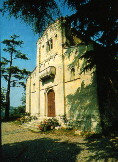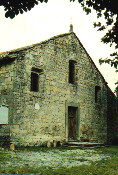The Romanesque churches which have survived
in the Modena Apennines do not have their own strong architectural
personality but spring from the coming together of local experience
and the highly skilled Lombard masters. Visiting them is rather
like a treasure hunt, since they are often well off any modern
beaten track, and in some cases it takes a trained eye to appreciate
the authentically Romanesque features which have survived later
reworkings.
Church of S. Maria Assunta, Denzano (Marano sul Panaro)
A short detour from the main road along
the Panaro valley brings us to Denzano, where we find the Romanesque
apse of the church of S. Maria Assunta still intact. Here the
regular, squared stones are used to form the typical motif of
hanging arches enclosed in pairs of larger blind arches; in this
case, this familiar decorative element of Romanesque architecture
has a special feature, since the arches finish in small shelves
that seem to support human-like heads.

Pieve di Trebbio
This "pieve" (the word means
a mother church) was founded in the IX Century, making it one
of the most ancient sacred buildings in the Modena Apennines.
However, it has been reworked a great deal over the centuries;
for example, as its unnaturally clean appearance leads one to
suspect, the facade was reconstructed at the beginning of this
century, subdivided into three parts by lesenes and decorated
with hanging arches to imitate the Romanesque style. The sculpted
sarcophagus above the main door is an unusual feature. The nearby
baptistery was also built in the early 1900s, using the remains
of the old facade, so it is a fake but made from original materials.
Very fine details of a quality rare outside Modena itself can
be found in the capitals, which probably date from before the
year one thousand, and in the decoration of the archivolt
of a door on the South side. The lectern in "pietra
dell'ambone", which shows John the Apostle, is also
original.

Pieve di Renno
This, the mother church to over 30 others
during the XV Century, stands a few kilometres from the via Giardini
between Pavullo and Lama Macogno. It is of extremely ancient
origin, dated to the IX Century, and is rough but impressive and
austere in appearance. The very compact, undecorated facade now
includes the main door and three large windows opened in 1722.
Inside, two wheel-shaped monograms of Christ are sculpted on
one of the octagonal pillars.
Church of S. Vincenzo, Monte Obizzo (Pavullo)
On the apse, the only part of the original
XIII Century building remaining, two rows of animals, seen from
the front and the side in alternation, face each other under the
hanging arches.
Pieve di Rocca S. Maria
Also a short distance from the via Giardini,
this time below Serramazzoni, this ancient church (VIII-IX Century)
has also undergone considerable restoration on its facade and
in the upper part; the tower has been completely rebuilt. The
interior is unusual, divided into a central nave and two side
aisles resting on short, sturdy columns topped by capitals
with floral decorations that are certainly the church's most interesting,
authentic features; the stylised leaves are interwoven with plaits,
coils and six-pointed stars with constant inventiveness.
Pieve di Rubbiano
 On the basilica plan, this church has
a central nave and two side aisles, ending in three apses. While
many of the original decorations on the outside have been replaced,
most of the capitals inside can be dated between the IX
and early X Centuries (one, showing two lions attacking each other
with their teeth, symbolises the battle between good and evil).
The apses feature the recurrent Lombard motif of hanging arches,
containing a number of symbolic figures. The facade was completely
reconstructed during restoration work in the last century which
moved it one arch further back.
On the basilica plan, this church has
a central nave and two side aisles, ending in three apses. While
many of the original decorations on the outside have been replaced,
most of the capitals inside can be dated between the IX
and early X Centuries (one, showing two lions attacking each other
with their teeth, symbolises the battle between good and evil).
The apses feature the recurrent Lombard motif of hanging arches,
containing a number of symbolic figures. The facade was completely
reconstructed during restoration work in the last century which
moved it one arch further back.
Church of Monte S. Giulia, Monchio
What can now been seen on the top of
Monte S. Giulia, in the Parco della Resistenza, is only a reconstruction
of the church which used to stand there until the German bombardment
of 8 January 1945. The bell-tower has disappeared but the apses
have been rebuilt, while the plain facade had already been reworked
in 1780. Just some of the outer walls and the central apse and,
inside, a few capitals and column bases, remain of the original
church, an important foundation with authority over many surrounding
churches in the XII Century.
Abbey church of Frassinoro
Founded in 1071 by Beatrice of Lorraine,
Marquess of Tuscany, the Abbey stood on a very important route
from the Po Valley to Tuscany. In the XV Century a landslide
ruined the abbey and the adjoining Benedictine monastery, which
was not rebuilt. Today's church is the result of rebuilding work,
with a few traces of the richness of the original building in
the form of a pink marble column or a white marble sculpted capital
amongst the grey of the sandstone. Lions and griffins from the
Medieval bestiaries appear in some capitals and in a bas relief
on an inside wall.
Church of S. Michele, Fiumalbo
In a panoramic position some distance
from either Fiumalbo or the nearer town of Pievepelago, this church
has been reworked several times over the centuries. All that
remains from the Romanesque period is the small apse with characteristic
slit windows, topped by a cornice with sober decoration.
Oratory of S. Biagio, Roncoscaglia
This building, not far from Sestola,
has a plain facade only interrupted by the main doorway, with
six archivolts. Two of these and the architrave are decorated
with vines, a Christian symbol referring to the "Lord's Vineyard",
also found on the doorway on the South side, with a series of
three concentric rings symbolising the Trinity.
Church of S. Giovanni, Vesale (Sestola)
Restoration work in the XVII Century
has spared only the apse, with a cornice of hanging arches, with
a lion in the centre recalling the animal figures at Monte Obizzo.
The church is built on a rock outcrop at the end of the village
square, to which its apse provides an attractive backdrop.